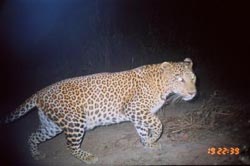Look out squirrels: Leopards are new backyard wildlife

Camera traps set up at night in a densely populated region of India virtually devoid of wilderness revealed leopards, striped hyenas, jackals -- and lots of people.<br><br>Credit: Project Waghoba<br>
The study found as many as five adult large carnivores, including leopards and striped hyenas, per 100 square kilometers (38 square miles), a density never before reported in a human-dominated landscape.
The study, called “Big Cats in Our Backyards,” appeared in the March 6 edition of the journal PLoS One. Authors include: Vidya Athreya and Ullas Karanth of the Wildlife Conservation Society and Centre for Wildlife Studies in Bangalore; Morten Odden of Hedmark University College; John D. C. Linnell of the Norwegian Institute for Nature Research; and Jagdish Krishnaswamy of Asoka Trust for Research of Ecology in the Environment.
Using camera traps, the authors founds that leopards often ranged close to houses at night though remained largely undetected by the public. Despite this close proximity between leopards and people, there are few instances of attacks in this region. The authors also photographed rusty spotted cat, small Indian civet, Indian fox, jungle cat, jackal, mongoose – and a variety of people from the local communities. The research took place in western Maharashtra, India.
“Human attacks by leopards were rare despite a potentially volatile situation considering that the leopard has been involved in serious conflict, including human deaths in adjoining areas,” said big cat expert Ullas Karanth of WCS. “The results of our work push the frontiers of our understanding of the adaptability of both humans and wildlife to each other's presence.”
The authors say that the findings show that conservationists must look outside of protected areas for a more holistic approach to safeguarding wildlife in a variety of landscapes.
The Wildlife Conservation Society saves wildlife and wild places worldwide. We do so through science, global conservation, education and the management of the world's largest system of urban wildlife parks, led by the flagship Bronx Zoo. Together these activities change attitudes towards nature and help people imagine wildlife and humans living in harmony. WCS is committed to this mission because it is essential to the integrity of life on Earth. Visit http://www.wcs.org.
Special Note to the Media: If you would like to guide your readers or viewers to a Web link where they can make donations in support of helping save wildlife and wild places, please direct them to http://www.wcs.org.
Media Contact
More Information:
http://www.wcs.orgAll latest news from the category: Ecology, The Environment and Conservation
This complex theme deals primarily with interactions between organisms and the environmental factors that impact them, but to a greater extent between individual inanimate environmental factors.
innovations-report offers informative reports and articles on topics such as climate protection, landscape conservation, ecological systems, wildlife and nature parks and ecosystem efficiency and balance.
Newest articles

Properties of new materials for microchips
… can now be measured well. Reseachers of Delft University of Technology demonstrated measuring performance properties of ultrathin silicon membranes. Making ever smaller and more powerful chips requires new ultrathin…

Floating solar’s potential
… to support sustainable development by addressing climate, water, and energy goals holistically. A new study published this week in Nature Energy raises the potential for floating solar photovoltaics (FPV)…

Skyrmions move at record speeds
… a step towards the computing of the future. An international research team led by scientists from the CNRS1 has discovered that the magnetic nanobubbles2 known as skyrmions can be…





















